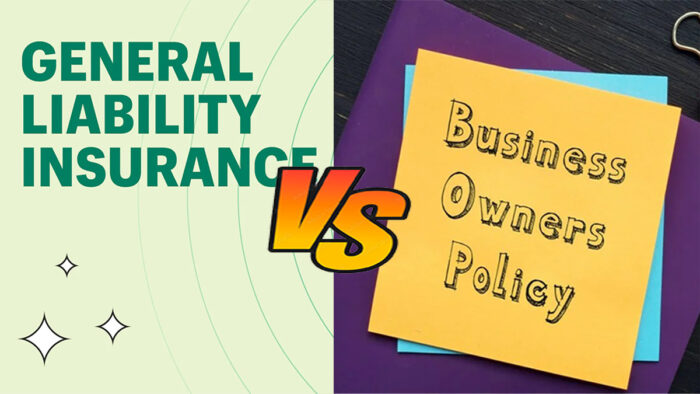General liability insurance and business owner’s policy (BOP) are two crucial components of a business’s risk management strategy, offering distinct advantages and coverage. General liability insurance primarily focuses on third-party claims arising from incidents such as bodily injury, property damage, and personal injury, including libel and slander.

This insurance provides financial protection for legal fees, settlements, and judgments against the business, ensuring it can continue operating while managing these costs. However, general liability insurance does not cover damage to the business’s property or loss of income due to interruptions.
What is General Liability Insurance?
General liability insurance, a vital type of small business insurance, compensates third parties for injuries or property damage when a business is legally responsible. This insurance is often mandatory for financial lenders, landlords, licensing boards, and business clients, making it essential for business operations.
What Does it Cover?
General liability insurance protects businesses from various claims, including bodily injury, property damage, and personal injury. If a business is sued, this insurance covers legal defense costs, court expenses, judgments, and settlements for claims within the policy’s scope. Here’s a closer look at what general liability insurance covers:
- Bodily injuries caused by your business: General liability insurance covers injuries resulting from business operations. For instance, if a customer is hurt on business premises, the insurance can pay for medical bills and legal defense costs if the customer sues the business.
- Property damage caused by your business: If a customer’s property is damaged due to business activities, the customer can make a claim, and general liability insurance will cover it. For example, if an employee damages a customer’s laptop or an outdoor sign falls on a customer’s car, the insurance will pay for the damage.
- Personal injury: Personal injury in liability insurance does not refer to physical injuries but instead covers issues like slander and libel. These are standard parts of general liability insurance, covering copyright violations in business ads or harming someone’s reputation through negative statements.
General liability insurance is a crucial risk management tool for businesses, providing financial protection against various claims, including bodily injury, property damage, and personal injury. By covering legal defense costs, court expenses, judgments, and settlements, this insurance helps businesses maintain their operations and reputation in the face of potential liabilities.
What Does It Not Cover?
General liability insurance offers substantial coverage for businesses, but it does not extend to certain specific scenarios. It does not cover business-related auto accidents, employee injuries and illnesses, damage to business property, professional service errors, claims exceeding policy limits, or illegal actions by the business or its employees.
To address these exclusions, businesses may require additional types of insurance:
- Employee injuries and illnesses: Workers’ compensation insurance is necessary to provide coverage for employee injuries.
- Auto accidents: Commercial auto insurance protects against accidents during business operations, while hired or non-owned auto insurance covers personal or rented vehicles used for work.
- Professional mistakes: Errors and omissions (E&O) insurance, also known as professional liability insurance, offers coverage for errors made during work.
- Theft and property damage: General liability insurance does not protect business equipment or property from theft or damage; commercial property insurance is essential for this coverage.
- Intentional acts: Insurance does not cover deliberate actions, such as intentional damage like throwing a computer out of a window or illegal activities by the business or its employees.
Understanding these limitations helps businesses tailor their insurance coverage to ensure comprehensive protection against a wide range of risks and liabilities.
What is Business Owner’s Policy?
A business owner’s policy, often abbreviated as BOP, is a comprehensive insurance solution designed to protect businesses from the primary risks associated with property damage and liability. This integrated policy combines essential coverages that a business owner typically requires into a single package, streamlining the insurance process and offering convenience.
BOPs are generally sold at a price lower than the total cost of the individual coverages when purchased separately, providing businesses with a cost-effective insurance solution. By bundling these essential coverages, a BOP ensures that businesses are well-equipped to handle various risks and potential losses, all while enjoying the benefits of a more affordable insurance option.
What Does Business Owner’s Policy Cover?
A Business Owner’s Policy (BOP) is a comprehensive insurance solution that combines essential property and liability coverages into a single package, offering small and medium-sized businesses a convenient and cost-effective way to protect themselves against various risks. Understanding what a BOP covers and what it does not cover is crucial for businesses to ensure they have the right insurance in place to safeguard their operations and assets.
- Property damage
- Peril coverage
- Business interruption protection
- Liability coverage
- Optional coverages are available for customization based on business needs.
What a Business Owner’s Policy Does Not Cover?
- Business-related auto accidents
- Employee injuries and illnesses
- Damage to business property
- Mistakes in professional services
- Claims exceeding policy limits
- Illegal acts by the business or its employees
While a business owner’s policy provides a broad range of coverage for businesses, it’s essential to be aware of its limitations to ensure comprehensive protection. By understanding what a BOP covers and what it excludes, businesses can make informed decisions about their insurance needs and consider additional coverage options to address specific risks. With the right insurance in place, businesses can mitigate potential liabilities and disruptions, allowing them to focus on their growth and success with confidence.
General liability insurance vs. Business Owner’s policy: What’s the difference?
General liability insurance and Business Owner’s Policy (BOP) are two essential insurance policies for businesses. While they share some similarities, they have distinct differences that business owners should understand to make informed decisions about their insurance needs. This table summarizes the key differences and similarities between general liability insurance and BOP.
| Aspect | General liability insurance | Business owner’s policy |
| Coverage | Covers lawsuits involving bodily injuries, property damage, and advertising injuries caused by the business to third parties | Includes general liability insurance, commercial insurance, and business interruption insurance in one policy |
| Property insurance | Does not include property insurance | Includes commercial property insurance to cover business asset |
| Cost | Typically less expensive than a BOP, it covers only third-party liabilities | Usually less expensive than buying each type of insurance separately |
| Availability | Available to almost any business | Typically limited to low-risk businesses |
| Endorsement | Can be customized with additional coverage endorsements | Can be customized with additional coverage endorsement |
| Similarities | Both are essential for businesses to protect against common risks and liabilities. | Both can be customized to meet specific business needs and offer a cost-effective solution for businesses seeking comprehensive coverage. |
This table provides a clear and concise comparison between general liability insurance and business owner’s policy (BOP) based on the information from Forbes.



